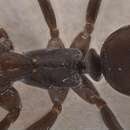Taxonomic History
provided by Antweb
Formica candida Smith, 1878b PDF: 11 (q.) KYRGYZSTAN. Palearctic.
AntCat AntWiki HOLTaxonomic history
[Smith's description is repeated by
Bingham, 1903 PDF: 335 (footnote).].Junior synonym of
Formica gagates:
Forel, 1894c PDF: 403.Junior synonym of
Formica picea Nylander, 1846:
Emery, 1925d PDF: 249;
Karavaiev, 1936: 231;
Dlussky, 1967a PDF: 61;
Bolton, 1995b: 201.[Note:
Formica candida junior synonym of
Formica picea Nylander, 1846 (synonymy by
Dlussky, 1967a PDF: 61); hence
Formica candida treated as first available replacement name for
Formica picea Nylander, 1846 (Bolton, 1995b: 192).].Status as species:
Dalla Torre, 1893 PDF: 193;
Bolton, 1995b: 192;
Espadaler, 1997g PDF: 27;
Chang & He, 2002a PDF: 51 (in key);
Czechowski et al., 2002 PDF: 81;
Imai et al., 2003 PDF: 57;
Seifert, 2004 PDF: 35 (redescription);
Radchenko, 2005b PDF: 161;
Schultz et al., 2006 PDF: 203;
Gratiashvili & Barjadze, 2008 PDF: 132;
Guénard & Dunn, 2012 PDF: 31;
Bharti et al., 2016 PDF: 27.
- bibliographic citation
- AntWeb. Version 8.45.1. California Academy of Science, online at https://www.antweb.org. Accessed 15 December 2022.
Biology
provided by Arkive
The nest, which is small and conical in shape, is made from Sphagnum moss and grasses, and is typically located in wet boggy areas (4), often inside tussocks of purple moor grass (Molinia caerulea) (6). The nests often become saturated or submerged for short periods, despite being built above the water level of the bog (4). Nests typically contain a single queen and up to 1000 workers (4). In many species of ant, the pupae are surrounded by a cocoon in order to prevent desiccation; black bog ant pupae often lack cocoons, perhaps because the nest is so moist that desiccation is unlikely (4).
Conservation
provided by Arkive
The black bog ant is a UK Biodiversity Action Plan (UK BAP) priority species, and a Species Action Plan has been produced to coordinate its conservation. It is also included in English Nature's Species Recovery Programme, which has funded research into the species. Studies have investigated the effects of grazing on the black bog ant, in order to find the optimal grazing regimes to maintain populations of the ant (6).
Description
provided by Arkive
This rare, medium-sized ant is black and shiny (4).
Habitat
provided by Arkive
Usually found in lowland Sphagnum bogs; this species is typically found in the transitional zone where wet heath meets valley mire or bog (2).
Range
provided by Arkive
In the UK, this species has always been rare (5), records are restricted to sites in the New Forest in Hampshire, the Dorset heaths and a locality in south Wales (2); an old record from the Isle of Wight may be erroneous (3). Elsewhere, it is found from the Pyrenees, reaching east to Japan, and from the Apennines in the south to Arctic Sweden (4).
Status
provided by Arkive
Classified as Endangered in Great Britain (3).
Threats
provided by Arkive
Main threats to this species include the loss of boggy and wet habitats (4), particularly through drainage (5), resulting in the lowering of the water table and conditions becoming too dry for the ant (3). At sites where the water table is lowered, invasion of the habitat by trees and scrub will lead to the loss of black bog ant colonies; excessive year-round grazing by livestock also appears to be detrimental (2). Prolonged periods of drought, pollution of watercourses and regular heathland fires will result in the loss of colonies (2).

